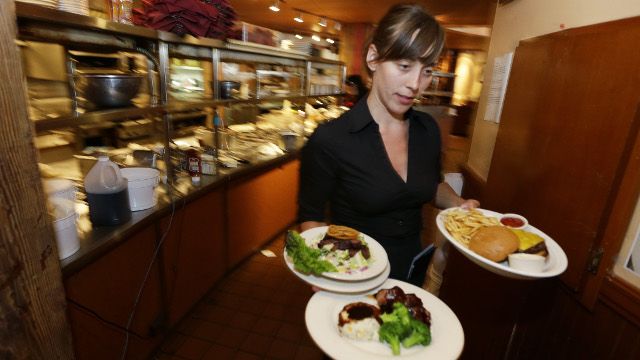
In 1991, the US invaded Iraq for the first time. That year, the Soviet Union would dissolve into 15 independent states. Emma Roberts was born. Dances with Wolves won the Oscar for Best Picture, and Bryan Adams’ “Everything I Do, I Do It For You” topped Billboard’s chart as the year’s top hit.
It also marked the last time that the federal minimum wage for tipped workers was increased — by a whopping four cents, from $2.09 per hour to $2.13. At the time, the minimum for tipped workers was half of the overall floor of $4.25. Today, it stands at just 29 percent of the regular minimum wage (which, at $7.25 per hour, is already well below its real peak value of $10.71 in 1968).
On Thursday, Sylvia Allegretto and David Cooper released a report for the Economic Policy Institute (EPI) detailing who these workers are, how many of them are struggling to make ends meet, and debunking a few common myths about tipped work.
They write:
The creation of the tip credit—the difference, paid for by customers’ tips, between the regular minimum wage and the sub-wage for tipped workers—fundamentally changed the practice of tipping. Whereas tips had once been simply a token of gratitude from the served to the server, they became, at least in part, a subsidy from consumers to the employers of tipped workers. In other words, part of the employer wage bill is now paid by customers via their tips.
Today, this two-tiered wage system continues to exist, yet the subsidy to employers provided by customers in restaurants, salons, casinos, and other businesses that employ tipped workers is larger than it has ever been. At the federal level, it currently stands at $5.12 per hour.
Proposed federal minimum-wage legislation, the Fair Minimum Wage Act of 2014—also known as the Harkin–Miller bill—would not only increase the federal regular minimum wage to $10.10, but for the first time in decades would also reconnect the subminimum wage for tipped workers back to the regular minimum wage by requiring the former be equal to 70 percent of the latter. This would be a strong step in the right direction; however, we present evidence that tipped workers would be better off still if we simply eliminated the tipped minimum wage, and paid these workers the full regular minimum wage.
Some key findings:
- There are approximately 4.3 million tipped workers in the United States, and roughly 2.5 million are waiters and bartenders.
- Tipped workers’ wages typically fall at the bottom of the income ladder, even after accounting for tips.
- Tipped workers are a growing portion of the US workforce. “Employment in the full-service restaurant industry has grown over 85 percent since 1990, while overall private-sector employment grew by only 24 percent,” write the authors.
- “Ensuring fair pay for tipped workers is also a women’s issue. Women comprise two out of every three tipped workers; of the food servers and bartenders who make up over half of the tipped workforce, roughly 70 percent are women.”
- The poverty rate for tipped workers (12.8 percent) is nearly twice that of working people subject to the full minimum wage (6.5 percent).
- “Tipped workers have a median wage (including tips) of $10.22, compared with $16.48 for all workers.”
- The public subsidizes the incomes of tipped workers twice: directly, when we leave a gratuity, and indirectly, as 46 percent of them rely on public benefits to make ends meet.
Most important, the study blows up the myth that raising tipped workers’ to the ordinary minimum wage kills service jobs. “Paying tipped workers the regular minimum wage has had no discernible effect on leisure and hospitality employment growth in the seven states where tipped workers receive the full regular minimum wage,” Allegretto and Cooper write. “In fact, sector growth in these states has been stronger since 1995 than in the states where tipped workers are paid a subminimum wage.”
The hospitality industry often claims that raising tipped workers’ base salaries won’t help them because customers will only tip less, but in the seven states where tipped workers are guaranteed the same minimum wage as everyone else, overall earnings are higher and poverty rates are lower.
The study also dispels the notion that tipped workers tend to be college kids or young adults just starting out in the workforce. While tipped workers do skew younger than the population as a whole, 6 in 10 are at least 25 years old, and 3 in 10 are 40 and above.
You can read the entire report at EPI »


